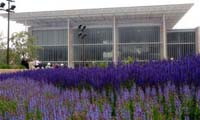 Chicago museum's new wing features "Flying Carpet"
Chicago museum's new wing features "Flying Carpet"Airy, transparent, and welcoming are some attributes ascribed to Renzo Piano's new wing for the Art Institute of Chicago.
The famed Italian architect's glass, aluminum and limestone wing, which is due to open in the spring, makes several references to Chicago's legacy as a pioneer of steel-and-glass-framed skyscrapers that first allowed sunlight into what had been dank downtowns.
"It will be one of the most brightly lit museums," said Art Institute spokesman Erin Hogan, who led a recent tour of the unfinished Modern Wing.
An exterior of floor-to-ceiling glass panels encased in aluminum mullions and tapered steel columns create a sensation that the rectangular-shaped building is floating. Limestone blocks were cut from the same Indiana quarry as those that built the century-old neoclassical Art Institute.
"It's not overwhelming in scale, it's not pompous," said museum director James Cuno, who is using the addition's nearly 300,000 square feet of gallery space to reinstall the museum's encyclopedic collection to create "a more coherent experience" for viewers.
"It's humane in scale and size and is made from soft materials, plaster and wood, and simple materials, glass and steel," he said.
The $300 million cost was covered primarily by the city's elite. The museum's collection is highlighted by Georges Seurat's huge pointillist masterpiece "A Sunday Afternoon on the Island of La Grand Jatte," which will be rehung near a second-floor entryway into the new wing.
The wing's overhanging roof, dubbed the Flying Carpet, features curved panels that channel light to skylights filtered by scrims which will illuminate the museum's early 19th Century collection of works by Picasso, Braque, Giacometti and others.
"Natural light is not only better for seeing works of art, it recharges one's batteries," Cuno said.
The third-floor galleries' artificial lighting will automatically adjust to the amount of natural light available. Cavernous galleries are housed within double-glass walls, with the gap between the two layers a buffer against Chicago's climate and street sounds.
Besides the attention to architectural geometry and detail, Piano uses a bridge to join the museum to Millennium Park across Monroe Street, which is visited by millions annually.
Those who wander up the 620-foot bridge's gentle slope arrive at the new wing's free, open-air sculpture garden that offers views and sounds from the park's Frank Gehry-designed concert stage and a glimpse of his winding bridge.
"Gehry's bridge is a river that doesn't know where it's going. It meanders," Hogan recalled Piano as saying. "Mine knows exactly where it is going."
The new wing will offer the museum's curators space to show off a selection from the 20,000 photographs, 70,000 drawings and prints, and scores of paintings and sculptures that normally sit in storage. It has brought welcome attention, and generated bequests from collectors, Cuno said.
It also provides children an expanded, and free, education center with its own entrance. It joins a lengthy list of completed or planned additions at museums across the United States, from New York's remade Museum of Modern Art to the innovative addition to Kansas City's Nelson-Atkins Museum of Art.
"Maybe not since the 1960s have we had such expansion in museums -- that's in attendance as well as physical size," Cuno said.
"There's something about the renewed vigor in museums' engagement with their communities that is characteristic of our age."
(Editing by Michael Conlon and Patricia Reaney)
 Chicago museum's new wing features "Flying Carpet"
Chicago museum's new wing features "Flying Carpet"